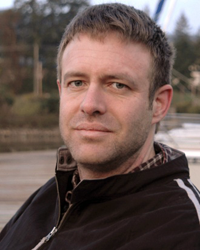
- Consumption
- Random House (2005)
- Bookstore Finder
Kevin Patterson's writing is vivid, emotionally acute and bracingly smart. His first work, the sailing memoir The Water in Between, was a New York Times "notable book," and his short-story collection, Country of Cold, won the Rogers Writers' Trust Fiction Prize. But it's not just his literary craftsmanship that stokes the envy of his fellow writers. More maddening is that he is this good and he has a day job.
Patterson, who lives on Saltspring Island, is a doctor of internal medicine at Nanaimo General Hospital. He put himself through medical school by joining the Canadian Army, and next February he will go to Afghanistan to treat civilians at a hospital in Kandahar.
His latest book, Consumption, was inspired by his experiences as a doctor in the Arctic, where he has spent part of every year since 1994. Consumption began as a non-fiction account of the abrupt transformation of Inuit communities. In a short period of time, the Inuit have changed from suffering the diseases of deprivation -- particularly starvation -- to the diseases of affluence, such as cancer, cardiovascular disease and diabetes. But as Patterson wrote about the medical and psychological impact of acculturation, he kept returning to the underlying issues of loneliness, fear and social dislocation. These, he realized, would be better probed using fictional characters, and so Consumption became his first novel.
The book brought him to Vancouver last week for a Vancouver International Writers Festival preview event at the Norman Rothstein Theatre, where he appeared with Mary Lawson, whose The Other Side of the Bridge won a long-list nomination for the Man Booker Prize. The festival's core events run from October 17 to 22 on Granville Island.
Consumption begins in 1962, when Victoria, an Inuit girl, is diagnosed with tuberculosis and evacuated to the south. When she rejoins her family six years later, she is healthy but culturally estranged. In her new home of Rankin Inlet no one really fits in, however. The community is in the midst of wrenching change as the latest technologies, diamond fever and new patterns of consumption all arrive from the south.
"This novel is not about the problems of the Inuit, it is about our problems examined partly through the lens of the Inuit," Patterson told me when we met for breakfast last week at the Sylvia Hotel. He is a trim man who is in his 40s but looks younger -- except for the wrinkles at the corners of his eyes, a consequence of weeks spent squinting into the distance at the helm of his ketch.
Here is what else Patterson had to say...
On the North:
The closest thing I've ever encountered to the tundra is the open ocean 1,000 miles offshore, on a particularly bad day. Part of what stirs me about the Inuit and the north is the sense of wonder I feel that people survived there, in that climate and with no wood.
Think about the bowhead whale hunt, for example. It's just amazing. I mean, you are in a kayak made from sealskin, and you have a piece of driftwood with a sharpened rock tied to it, and you are hunting these 50-ton animals!
But when you pulled the whale ashore your whole band ate well for weeks. You just set up a camp beside the carcass. Each morning you got up and chopped off another square foot of frozen blubber and skin and took it into the igloo. Your biggest job then was to fend off the dogs and polar bears.
On why narwhale blubber is better than Cheese Doodles:
When I first went up north in 1994 there was no diabetes. As late as the 1960s, people were travelling to Cree villages in the northern boreal forests to find out why they are immune to diabetes. Now, in a place like Norway House (a Cree community in northern Manitoba), the prevalence of diabetes in adults is 40 per cent. That's just amazing! Diabetes is at eight to 10 per cent in southern Canada, and it's a disaster down here.
While I'm working up north, most of what I do is see diabetics. I give them their pills, and talk about how much better it is to eat char and seal and narwhale blubber than to eat Cheese Doodles.
In the south when we talk to people about diet we say, "Avoid animal fat." But in 1994, when I went up to the Arctic, there was no coronary artery disease, no diabetes. Because in order to get narwhale blubber, you had to spend days in your boat on the ocean, then shoot one and put a harpoon in it and pull it ashore. Or to get caribou you walked the land for hours and shot one and gutted it, and then walked back with the meat. The whole lifestyle kept people thin and stopped them from having vascular disease.
On why Cheese Doodles would be far less destructive if they weighed 50 tonnes and swam in the Arctic Ocean and we chased them with harpoons:
People can eat almost whatever they want, and their bodies will deal with it. The key is that we keep moving. We were meant to move. When we withdraw into our little caves to watch a glowing screen, we become sick and dying mammals. Because only sick and dying mammals withdraw into their caves.
On the big dieting lie:
The emphasis in the south is on what we eat, and that's goofy. People have no capacity to deny themselves things they want. We're just not wired for it. All diets fail. If you measure them at five years, people who try a diet are at pre-dieting weight or higher.
One thing that works is exercise, because people can become fond of exercise. People cannot become fond of dieting. If you want a food, you will seek it out. Statistically insignificant numbers of people can achieve long-term weight loss through diet change alone.
On the seductive life of the mind:
Obesity and diabetes in the north are partly a result of the life of the mind. That leads to a difficult problem, because much of what we value in our culture is this life of the mind. People who write books or make films or reflect upon the way we live, these are people who embrace the life of the mind, and I'm all about that.
And that's what we've exported to the north. The traditional life in the Arctic is really pretty brutal. Men were valued for distance vision and being a good shot. Nothing else mattered. If you were a tender husband or good storyteller or effective father, it hardly mattered.
Making the life of mind available to people through the export of western culture, obviously it has tremendous appeal for them. But it has also led to acculturation at an incredible pace, which has been a disaster.
On globesity and the murderous influence of Van Halen:
The prevalence of obesity was stable between World War Two and 1980, despite the car culture and the McDonald's golden arches everywhere. At about 1980 there was an abrupt uptick in obesity. My theory is that it was caused by hair/metal bands replacing disco. Since then it has been increasing at 50 per cent per decade. If we were still wearing sequins and shaking our booty on the disco floor, we'd be thin.
But seriously, all over the world this is happening. In Malaysia, childhood obesity is up 1000 per cent in 20 years. Some people call this the globesity epidemic.
The New England Journal of Medicine published a piece last year that proposed that for the first time in history, politically stable and prosperous nations are looking at a sustained drop in life expectancy. And this is a consequence of the explosion of diabetes and obesity.
On why so-called "fat taxes" are doomed to fail:
For starters, paradoxically, the obese are the poor. Because the poor are the sickest in every society.
And do you think that taxes are going work, when the most profound motivation -- to be sexy -- isn't enough!? Seventeen-year-olds only want one thing in this world, which is to be sexy. And obesity is up 400 per cent in teenagers.
I think what we need to do is re-engineer our cities. It's not about more gyms, because there are lots of gyms. We have to walk to work. We have to live in cities that require us to move to get through our days. There should be as many square feet of bicycle lanes in Vancouver as car lanes. It should just be such a pain in the ass to drive a car that most people don't. We need oil to cost $200 a barrel, for health reasons.
Chris Tenove's last books story for The Tyee was "Hunting Down a Killer in Paradise," about J.B. MacKinnon, who appears at the Vancouver International Writers Festival on Sat., Oct. 21 on the Politics and the Pen panel.
Other festival guests recently discussed or profiled in The Tyee are Eden Robinson in "Big Cities Need Bad Actors," Billie Livingston in "Feminist Fatales," Ryan Knighton in "Blind Man's Bluff," and Noah Richler in "What Books Define Us?" For complete festival program information, visit the Vancouver International Writers Festival website. Watch for more coverage of festival events and authors on The Tyee in the coming week. ![]()




